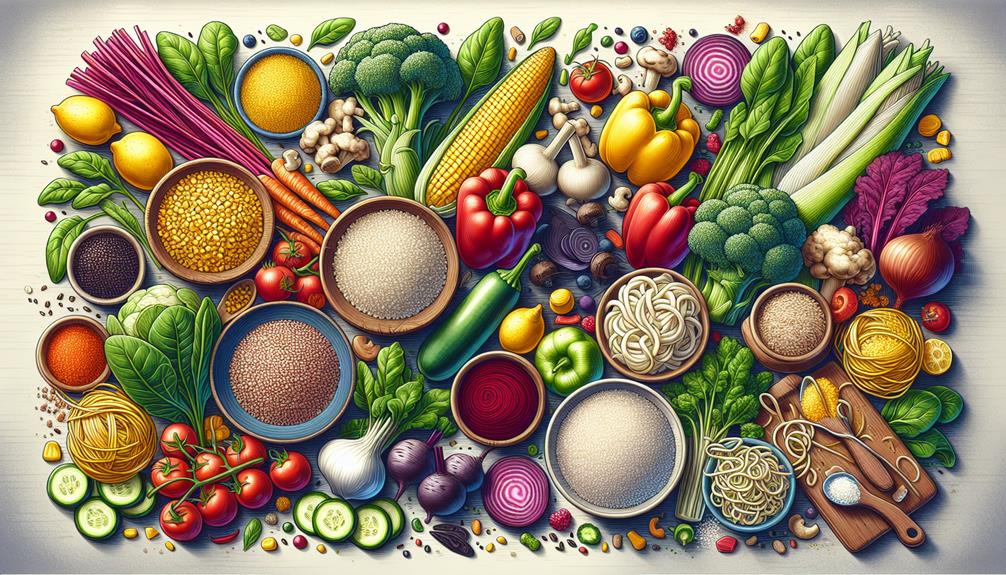Cutting carbohydrates from your diet can feel like navigating through a dense forest, but fear not, for we are here to guide you with strategies that will make it as seamless as a river flowing downstream. With these low-carb diet tips, you will discover how to make smart food choices, swap out high-carb ingredients, and incorporate protein and healthy fats to keep you satiated and energized throughout the day. So, if you're ready to embark on a journey towards a healthier lifestyle and shed those extra pounds, let's dive right in and uncover the secrets to successfully cutting carbohydrates.
Key Takeaways
- Low-carb diets can lead to significant weight loss compared to low-fat diets.
- Choose complex carbohydrates like whole grains, fruits, and vegetables.
- Swap high-carb ingredients with low-carb alternatives like zucchini noodles or almond flour.
- Incorporate protein-rich meals and healthy fats for weight management and overall health.
Understand the Basics
To successfully follow a low-carb diet, it is essential to have a clear understanding of the basics. There are many common misconceptions surrounding low-carb diets, but understanding the facts can help you make informed decisions about your health and nutrition.
One of the main benefits of a low-carb diet is weight loss. By reducing your carbohydrate intake, you can lower your insulin levels and promote fat burning. Studies have shown that low-carb diets can lead to greater weight loss compared to low-fat diets. Additionally, a low-carb diet can help improve blood sugar control, reduce cravings, and increase satiety, making it easier to stick to your weight loss goals.
Contrary to popular belief, a low-carb diet does not mean you have to give up all carbohydrates. It simply means choosing the right types of carbohydrates and consuming them in moderation. Opt for complex carbohydrates like whole grains, fruits, and vegetables instead of refined sugars and processed foods.
Choose Low-Carb Foods Wisely
Now that you have a clear understanding of the basics of a low-carb diet, it's time to focus on choosing low-carb foods wisely to optimize your weight loss and overall health. Making smart food choices is crucial when following a low-carb diet, as it helps you reduce your carbohydrate intake while still enjoying delicious and satisfying meals. Here are some low-carb food swaps and portion control tips to help you make the most out of your low-carb journey:
| Low-Carb Food Swaps | Portion Control for Low-Carb Meals |
|---|---|
| Swap regular pasta for zucchini noodles or spaghetti squash. | Measure your carbohydrates using a food scale or measuring cups to ensure you're eating an appropriate portion size. |
| Replace white rice with cauliflower rice or quinoa. | Fill half of your plate with non-starchy vegetables, a quarter with protein, and the remaining quarter with healthy fats. |
| Choose lettuce wraps or collard greens instead of bread for sandwiches. | Avoid mindless eating by eating slowly and savoring each bite. This will help you feel satisfied and prevent overeating. |
Swap Out High-Carb Ingredients

Consider swapping out high-carb ingredients in your meals to reduce your carbohydrate intake and maintain a low-carb diet. By making simple ingredient substitutions, you can still enjoy delicious meals while reaping the benefits of a low-carb diet. Here are some low-carb recipe ideas to get you started.
Instead of using traditional wheat-based pasta, try using spiralized vegetables like zucchini or spaghetti squash as a base for your pasta dishes. Not only are these options low in carbs, but they also provide additional nutrients and fiber. Another great alternative is cauliflower rice, which can be used in place of regular rice in dishes like stir-fries or fried rice.
When it comes to baking, replace all-purpose flour with almond flour or coconut flour. These low-carb flours are rich in healthy fats and provide a nutty or sweet flavor to your baked goods. You can also use flaxseed meal or chia seeds as a replacement for breadcrumbs in recipes.
For a low-carb pizza crust, try using a base made from cauliflower or a mixture of cheese and eggs. These options are not only low in carbs but also offer a unique and delicious twist to the traditional pizza crust.
With these simple swaps, you can enjoy your favorite meals while keeping your carbohydrate intake in check. By incorporating low-carb recipe ideas into your meals, you can reap the benefits of a low-carb diet, including weight loss, improved blood sugar control, and increased energy levels. So go ahead and get creative in the kitchen, and discover the endless possibilities of low-carb cooking.
Incorporate Protein and Healthy Fats
Incorporating protein and healthy fats into your meals is essential for maintaining a balanced and nutritious low-carb diet. These macronutrients not only provide satiety but also offer numerous health benefits. Protein is the building block of cells and tissues, helping to repair and build muscle mass. It also aids in weight management by boosting metabolism and reducing appetite. Healthy fats, on the other hand, are vital for brain function, hormone production, and nutrient absorption. They provide a steady source of energy and promote heart health.
To help you plan your low-carb meals, here are some healthy meal ideas that are rich in protein and healthy fats:
| Breakfast | Lunch | Dinner | Snack |
|---|---|---|---|
| Omelette with vegetables | Grilled chicken salad | Salmon with roasted | Greek yogurt with |
| and avocado | and olive oil dressing | broccoli and almonds | mixed berries |
Stay Consistent and Track Your Progress

To effectively maintain a low-carb diet, it is crucial to stay consistent with your meal choices and track your progress along the way. Consistency benefits your body's ability to adapt to a low-carb lifestyle and helps you achieve your desired weight loss goals. Here are four practical tips to help you stay consistent and track your progress on a low-carb diet:
- Plan your meals: Take the time to plan your meals in advance. This will help you avoid impulsive food choices and ensure that you have nutritious low-carb options readily available.
- Keep a food diary: Tracking what you eat and drink can provide valuable insights into your dietary habits. Use a food diary or a mobile app to record your meals, snacks, and beverages. This will help you identify any patterns or areas where you may need to make adjustments.
- Monitor your carb intake: Keep a close eye on your carbohydrate consumption. Aim to stay within your recommended daily carb limit and make adjustments as needed. Tracking your carb intake will help you maintain ketosis and stay on track with your low-carb diet.
- Measure your progress: Regularly track your weight, body measurements, and other relevant metrics. This will allow you to see how your body is responding to your low-carb diet. It can also provide motivation and help you make adjustments if necessary.
Frequently Asked Questions
Can I Still Eat Fruits and Vegetables on a Low-Carb Diet?
Yes, you can still enjoy fruits and vegetables on a low-carb diet. While some fruits may have higher sugar content, you can opt for lower-sugar options like berries. Additionally, you can include non-starchy vegetables as substitutes for higher-carb foods.
How Long Does It Take to See Results on a Low-Carb Diet?
How long does it take to see results on a low-carb diet? Well, it really depends on various factors like your starting weight, metabolism, and adherence to the diet. Patience and consistency are key to overcoming plateaus.
Can I Have Cheat Meals or Cheat Days While on a Low-Carb Diet?
You can have cheat meals or cheat days while on a low-carb diet, but it's important to plan them wisely. Incorporating cheat meals into your meal planning can help you stay on track and avoid feelings of deprivation.
Are There Any Potential Side Effects of Following a Low-Carb Diet?
Following a low-carb diet may have potential risks and long-term effects. It's important to consult with a healthcare professional to ensure it meets your individual needs and to monitor your health.
Can I Drink Alcohol While on a Low-Carb Diet?
Yes, you can drink alcohol while on a low-carb diet. However, be mindful of your choices. Opt for low-carb options like vodka or tequila, and mix with soda water or diet mixers. Moderation is key!
Conclusion
So, in conclusion, by following these low-carb diet tips and incorporating them into your lifestyle, you can effectively cut carbohydrates and achieve your health and weight loss goals. Remember to choose low-carb foods wisely, swap out high-carb ingredients, and incorporate protein and healthy fats into your meals. Stay consistent, track your progress, and enjoy the benefits of a healthier, low-carb lifestyle.













